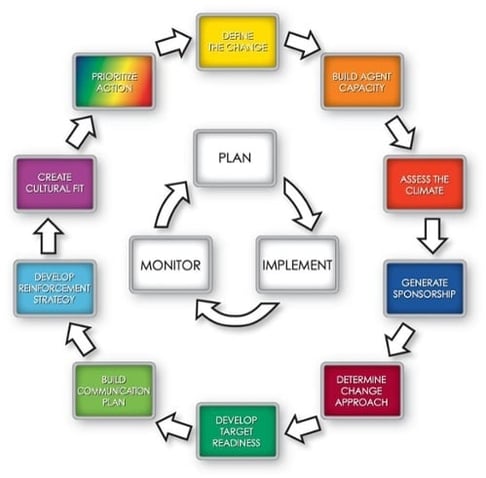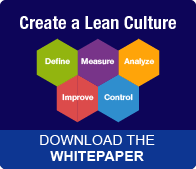Imagine a world in which your organization’s most complex issues are solved by a continuous improvement effort and then the new processes are implemented seamlessly into the organization. Where Lean isn’t just a process improvement approach for a few, but a culture shift for the whole organization. An organization that just doesn’t do “Lean,” but where a Lean mindset permeates through the organization. Sounds perfect, right? 
Utilizing the Accelerating Implementation Methodology (AIM) change management model in conjunction with your continuous improvement initiatives can help you achieve that dream. Here’s how:
Definition of Success
The end goal of every operational excellence project is to have people adopt and sustain a new behavior. Sounds obvious, yes? But in our experience, one of the most significant stumbling blocks to a continuous improvement solution is when a powerful new process has been developed, but the people who are supposed to use it… don’t. Remember, every continuous improvement project’s success needs to be measured by the following 5 metrics:
- On Time
- On Budget
- Technical Objectives Met
- Business Objectives Met
- Human Objectives Met
Ensuring all 5 of these metrics are achieved, including the human objectives, is the difference between installing and implementing a change. You must reach implementation in order to deem a project successful and get value realization for the project. Because the reality is... there is no process improvement unless people change their behavior. No behavior change, no improvement! It’s just that simple.
The Missing Piece in Process Improvement
The missing piece from most operational excellence initiatives is a standard deployment approach that addresses the critical “human side” of solution implementation. For example, every time a new process is introduced, there are potential human and cultural barriers that need to be identified and mitigated such as:
- How do we get the management team to fully commit to the new process and reinforce their people for adopting it?
- Whose way of working will be disrupted by this process, and to what degree?
- How will we get affected individuals motivated and ready for this change?
- How will we manage the inevitable resistance, including from leaders who may have their own political agendas?
AIM offers a robust set of tools and measurement diagnostics, along with a structured framework for managing these and other human elements of continuous improvement efforts. It is risk mitigation for the human elements of your initiatives. The application of the AIM change management methodology enables Lean Six Sigma teams to apply the same process framework approach to what is often considered to be the softer side, or what we call the people-side of process improvement.
Blending Continuous Improvement and Change Management
While it would seem logical to apply Lean Six Sigma first to identify the issues and then AIM as a bolt on at the end, we know from our experience that work on building readiness begins as early as the Define step in both processes. Thus, it is much better to integrate the two approaches very early on in order for business processes to be changed and adopted at speed. Each process improvement effort should begin with an “implementation mindset.”
Below are a just a few elements of the AIM Road Map that are considered when applying its principles, tactics and measurement diagnostics to a continuous improvement implementation:
- Define the Change – To measure whether you’re achieving the human elements of change you need to first define the behaviors you want to see in the future. How are people behaving now, and how do you want them to behave after the change? If you don’t define the behaviors you can’t reinforce and measure them.

- Assess the Climate – Does your past implementation history suggest a quality-hostile, or quality-friendly environment? You can’t ignore a poor implementation history, because it means that trust levels will be low, resistance will be higher, and speed to implementation will be impacted. It will take more time and more resources to implement your solution.
- Generate Sponsorship – A cascade of committed Sponsors is the most critical factor in implementation success and speed. Sponsors must Express, Model, and Reinforce commitment to the change.
- Develop Target Readiness – Invest in readiness early, or pay for it later with resistance! Develop strategies and tactics to manage resistance, while using proven techniques like involvement to pro-actively create readiness.
- Develop Targeted Communications-Absence of communication can cause fear of the unknown. Communications need to be cyclical, provide a feedback loop, and be in the language of the targeted audience. There is not just a single message, but multiple messages, all translated into various different Frames of Reference.
- Develop Reinforcements for Change- People will change their behavior more quickly when there are positive rewards for the desired behavior, balanced with negative consequences for failing to change. Reinforcement is the “secret sauce” to building a Lean culture in your organization. If you continue to reinforce people in the same ways you have always reinforced, you are maintaining the status quo. Start changing the reinforcements for a process improvement effort and you will start to see the culture shift you are seeking.
In adopting both Lean Six Sigma and AIM, organizations benefit from the application of not one, but two proven approaches to improve process performance. The first is working to identify and solve problem areas, the second is focused on the people-side of the equation to help ensure a successful implementation.
The interaction between operational excellence and change management is not either/or, but symbiotic. When used together, they will work in balance, depend on each other for survival, interact to the advantage of both parties, and provide a mutually beneficial relationship. Great solutions… implemented successfully. It’s a perfect combination.



